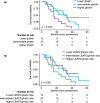Associations of postprandial ghrelin, liver-expressed antimicrobial peptide 2 and leptin levels with body composition, disease progression and survival in patients with amyotrophic lateral sclerosis
- PMID: 37658515
- PMCID: PMC10840749
- DOI: 10.1111/ene.16052
Associations of postprandial ghrelin, liver-expressed antimicrobial peptide 2 and leptin levels with body composition, disease progression and survival in patients with amyotrophic lateral sclerosis
Abstract
Background and purpose: Loss of appetite contributes to weight loss and faster disease progression in amyotrophic lateral sclerosis (ALS). Impairment of appetite control in ALS may include altered production or action of orexigenic (i.e., ghrelin) and anorexigenic (i.e., liver-expressed antimicrobial peptide 2 [LEAP2] and leptin) hormones. We aimed to determine if postprandial circulating ghrelin levels, LEAP2 levels, LEAP2:ghrelin molar ratio and leptin levels differ in ALS patients compared to non-neurodegenerative disease controls, and whether they are associated with disease progression and body composition.
Methods: In this prospective natural history study, we assessed postprandial plasma levels of ghrelin, LEAP2 and leptin in patients with ALS (cases; n = 46) and controls (controls; n = 43). For cases, measures were compared to changes in body weight, body composition and clinical outcomes.
Results: Postprandial ghrelin level was decreased by 52% in cases compared to controls (p = 0.013). LEAP2:ghrelin molar ratio was increased by 249% (p = 0.009), suggesting greater ghrelin resistance. Patients with lower LEAP2:ghrelin tended to have better functional capacity at assessment, as inferred by the ALS Functional Rating Scale-Revised (τ = -0.179, p = 0.086). Furthermore, ghrelin and LEAP2:ghrelin molar ratio correlated with diagnostic delay (ghrelin, τ = 0.223, p = 0.029; LEAP2:ghrelin, τ = -0.213, p = 0.037). Baseline ghrelin level, LEAP2 level, LEAP2:ghrelin ratio and leptin level were, however, not predictive of change in functional capacity during follow-up. Also, patients with higher postprandial ghrelin levels (hazard ratio [HR] 1.375, p = 0.048), and lower LEAP2:ghelin ratios (HR 0.828, p = 0.051) had an increased risk of earlier death.
Conclusions: Reduced postprandial ghrelin levels, coupled with increased LEAP2:ghrelin molar ratios, suggests a loss of ghrelin action in patients with ALS. Given ghrelin's actions on appetite, metabolism and neuroprotection, reduced ghrelin and greater ghrelin resistance could contribute to impaired capacity to tolerate the physiological impact of disease. Comprehensive studies are needed to explain how ghrelin and LEAP2 contribute to body weight regulation and disease progression in ALS.
Keywords: LEAP2; amyotrophic lateral sclerosis; disease progression; functional decline; ghrelin; leptin.
© 2023 The Authors. European Journal of Neurology published by John Wiley & Sons Ltd on behalf of European Academy of Neurology.
Conflict of interest statement
Frederik J. Steyn and Shyuan T. Ngo receive funding from Aeterna Zentaris GmbH. Frederik J. Steyn and Shyuan T. Ngo has consulted for Cytokinetics Inc. Jeffrey M. Zigman has consulted for Helsinn Healthcare S.A. and Dexcel Pharma Technologies Ltd and receives research funding from Novo Nordisk. The authors alone are responsible for the content and writing of this article.
Figures





Similar articles
-
Exploring the Role of Metabolic Hormones in Amyotrophic Lateral Sclerosis.Int J Mol Sci. 2024 May 7;25(10):5059. doi: 10.3390/ijms25105059. Int J Mol Sci. 2024. PMID: 38791099 Free PMC article.
-
Pre-prandial plasma liver-expressed antimicrobial peptide 2 (LEAP2) concentration in humans is inversely associated with hunger sensation in a ghrelin independent manner.Eur J Nutr. 2024 Apr;63(3):751-762. doi: 10.1007/s00394-023-03304-8. Epub 2023 Dec 29. Eur J Nutr. 2024. PMID: 38157050
-
LEAP2 deletion in mice enhances ghrelin's actions as an orexigen and growth hormone secretagogue.Mol Metab. 2021 Nov;53:101327. doi: 10.1016/j.molmet.2021.101327. Epub 2021 Aug 21. Mol Metab. 2021. PMID: 34428557 Free PMC article.
-
Ghrelin-LEAP2 interactions along the stomach-liver axis.Endocr J. 2025 Apr 1;72(4):341-353. doi: 10.1507/endocrj.EJ24-0543. Epub 2024 Dec 27. Endocr J. 2025. PMID: 39756956 Free PMC article. Review.
-
Ghrelin and leptin pathophysiology in chronic kidney disease.Pediatr Nephrol. 2013 Apr;28(4):611-6. doi: 10.1007/s00467-012-2380-9. Epub 2012 Dec 11. Pediatr Nephrol. 2013. PMID: 23229444 Review.
Cited by
-
The Effects of a Mediterranean Diet on Metabolic Hormones and Cytokines in Amyotrophic Lateral Sclerosis Patients: A Prospective Interventional Study.Nutrients. 2025 Apr 25;17(9):1437. doi: 10.3390/nu17091437. Nutrients. 2025. PMID: 40362746 Free PMC article.
-
Deciphering hypothalamic pathology in ALS: insights into non-motor symptoms and disease progression.EBioMedicine. 2025 Aug;118:105845. doi: 10.1016/j.ebiom.2025.105845. Epub 2025 Jul 11. EBioMedicine. 2025. PMID: 40651187 Free PMC article. Review.
-
Deficiency of leap2 promotes somatic growth in zebrafish: Involvement of the growth hormone system.Heliyon. 2024 Aug 15;10(18):e36397. doi: 10.1016/j.heliyon.2024.e36397. eCollection 2024 Sep 30. Heliyon. 2024. PMID: 39347412 Free PMC article.
-
Appetite loss in patients with motor neuron disease: impact on weight loss and neural correlates of visual food cues.Brain Commun. 2025 Mar 14;7(2):fcaf111. doi: 10.1093/braincomms/fcaf111. eCollection 2025. Brain Commun. 2025. PMID: 40144301 Free PMC article.
-
Exploring the Role of Metabolic Hormones in Amyotrophic Lateral Sclerosis.Int J Mol Sci. 2024 May 7;25(10):5059. doi: 10.3390/ijms25105059. Int J Mol Sci. 2024. PMID: 38791099 Free PMC article.
References
-
- Ngo ST, Steyn FJ, McCombe PA. Body mass index and dietary intervention: implications for prognosis of amyotrophic lateral sclerosis. J Neurol Sci. 2014;340(1–2):5‐12. - PubMed
-
- Shimizu T, Nagaoka U, Nakayama Y, et al. Reduction rate of body mass index predicts prognosis for survival in amyotrophic lateral sclerosis: a multicenter study in Japan. Amyotroph Lateral Scler. 2012;13(4):363‐366. - PubMed
Publication types
MeSH terms
Substances
Grants and funding
LinkOut - more resources
Full Text Sources
Medical
Miscellaneous

